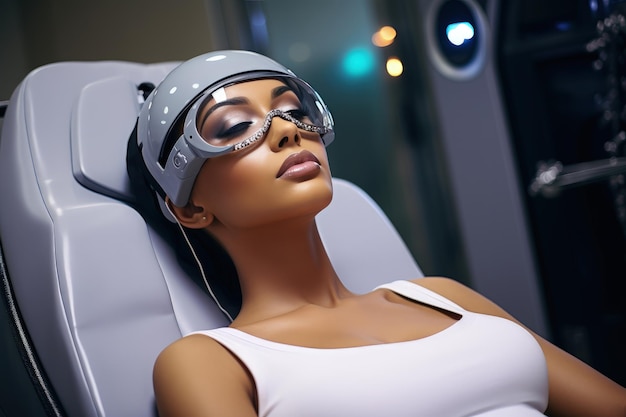In recent years, the beauty and skincare industry has seen an influx of innovative technologies promising to revitalize and rejuvenate the skin. Among these advancements is the LED face mask, a device that employs light-emitting diodes (LEDs) for various skin treatments. Users often grapple with the question of frequency: Can I use an LED face mask every day? This discourse will delve into the science behind LED therapy, cultural perceptions of skincare routines, and the safety implications of daily usage.
First and foremost, understanding the mechanisms of LED light therapy is crucial. LED masks typically incorporate several different wavelengths of light, each targeting unique skin concerns. For instance, red light is revered for its ability to stimulate collagen production and reduce inflammation, while blue light is renowned for its efficacy in combating acne by targeting the bacteria responsible for breakouts. Green light addresses hyperpigmentation, whereas yellow light can improve skin elasticity and tone. The harmonization of these treatments facilitates a comprehensive approach to skincare.
From a scientific standpoint, regular use of LED face masks may yield cumulative benefits for the skin. A plethora of studies suggest that repeated exposures can enhance the skin’s response, allowing for the substantial amelioration of various dermatological afflictions. When considering daily usage, it is essential to weigh the dosage of light exposure. Each session typically lasts between 10 to 30 minutes, depending upon the device’s design and the intended treatment. Recommendations from dermatologists often suggest starting with a frequency of two to three times a week, monitoring the skin’s response, and then adjusting the frequency accordingly.
However, the question of safety is paramount. The consensus among dermatologists is that LED light therapy is safe for most individuals. Unlike ultraviolet (UV) light, which can lead to skin damage and increase cancer risk, LED light does not possess the same harmful properties. Nonetheless, users should remain vigilant for any signs of adverse reactions, such as irritation or sensitivity. Individuals with photosensitivity or those on certain medications may need to exercise caution and seek professional advice before incorporating LED light treatments into their skincare regimens.
Moreover, the cultural context surrounding skincare can significantly influence perceptions of daily use. In various societies, skincare rituals are imbued with cultural significance, reflecting ideals of beauty and self-care. For instance, in many East Asian cultures, the meticulous layering of products is not just a treatment but a practice steeped in tradition. Yet, with the emergence of LED masks, a dichotomy arises between traditional practices and modern technology. The rising trend of integrating such devices into daily routines raises questions about cultural relativism and the acceptance of technological advancements in skincare.
In Western cultures, skincare practices often embrace quick and effective solutions, favoring products that promise immediate results. The fast-paced lifestyle might favor the convenience of LED treatments, heralding a shift towards more technology-driven approaches to beauty. However, this may inadvertently marginalize the rituals embedded in cultural practices that emphasize gradual, meticulous care. Understanding this intersection invites a broader discourse on how technology is reshaping notions of beauty across various cultures.
As skincare enthusiasts explore the potential benefits of daily usage, it is paramount to consider the holistic approach to skincare. The integration of diet, hydration, sun protection, and rest plays an irrefutable role in achieving optimal skin health. LED therapy should not be viewed as a panacea, but rather as a complementary component of a more comprehensive skincare strategy. Subsequently, practitioners should advocate for a balanced regimen that harmonizes the use of technology with foundational skincare practices.
Furthermore, it is imperative to discuss the accessibility of LED face masks. The market offers a vast array of options, catering to diverse economic classes and consumer needs. As such, the democratization of skincare technology emerges as a key theme. LED masks range from professional treatments available in dermatological clinics to affordable, at-home devices. However, disparities in access can reinforce social inequalities. The ability to utilize cutting-edge skincare technology may be limited to affluent individuals, while those of lower socioeconomic status may remain reliant on traditional methods.
Ultimately, the question of whether one can use an LED face mask every day is multifaceted. Scientific evidence suggests potential advantages with increased frequency, yet cultural contexts and individual skin responses necessitate personalized approaches. Cultural relativism, when applied to skincare, underscores the importance of understanding varying beauty norms and practices across societies. In this dynamic landscape, embracing a more nuanced and inclusive dialogue surrounding skincare technology can foster better understanding and wider acceptance.
In conclusion, while the allure of daily LED face mask usage is understandable, a careful consideration of individual skin responses and cultural context is essential. As advancements in skincare technology continue to evolve, it is pertinent for consumers to remain informed, discerning, and respectful of the diverse traditions that shape our understanding of beauty. In a world that increasingly favors instant gratification, the art of thoughtful skincare calls for a return to mindful practices, blending tradition with innovation to cultivate both health and aesthetic appeal.
